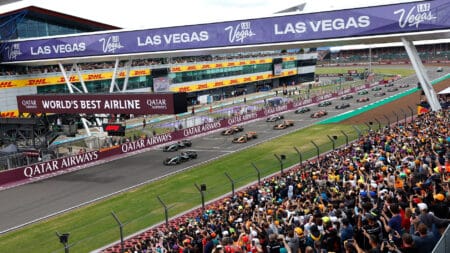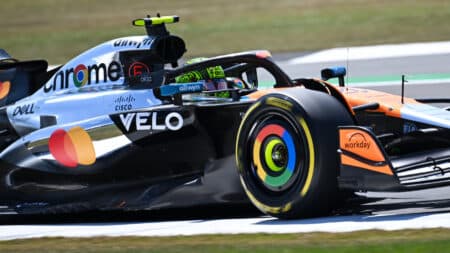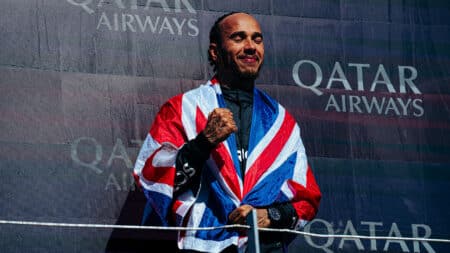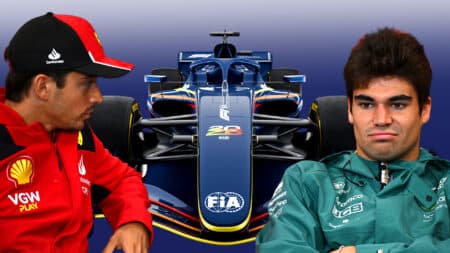
Tomorrow's F1 starting grid for the 2025 British Grand Prix
Max Verstappen will start on pole for the 2025 British Grand Prix after a brilliant last gasp qualifying lap. Here's how the starting grid looks for Sunday's race at Silverstone
Click here to buy the lead image.
In December we published a special supplement in association with Dunlop celebrating that never-say-die fighting spirit at the heart of motor sport.
There were 10 of the greatest examples of triumph and spirit overcoming seemingly insurmountable odds, from the 1950s to the present day. All were linked not only by the brand of tyre they ran on – but by grit, determination, resilience and a refusal to accept anything over than the very best they could achieve.
Voting was open to the public on a special Dunlop website, and the votes are now in. We present the top-five, in reverse order:
5th: Jacky Ickx
24 Hours of Le Mans, 1977
Dynamite recovery at Le Mans in June and arrive, covered in glory, on Formula 1’s doorstep in July. It seemed so neat – and simple – for two French industrial giants: Renault and Michelin. But, as their Alpine A442 Turbos had proved so conclusively in 1976, beating Porsche is never easy.
Ickx had fallen out of love with Formula 1 and in turn fallen out of favour. (The first superstar to suffer burnout?) Pairing him with fellow three-time Le Mans winner Henri Pescarolo, however, backfired when they retired from second place after 45 laps because of a holed piston.
It was decided to plug the redundant Ickx into the other car. The effect on it was electric. Having appeared dead in the water when a defective fuel injection pump cost it 30 minutes and plunged it to 41st position after just two hours, the corpse was now twitching.
Although the car suffered more oversteer than his original, Ickx was mighty through the night and broke the lap record, set by Matra’s François Cevert in 1973. The Dunlop-shod Porsche was also able to run as much as five laps longer between fuel stops.
Renault began to panic however when its second and third-placed cars suffered mechanical problems during the early hours of Sunday morning. Then, at 9am, the lead car blew a piston.
Ickx and Porsche led, but hang on! Smoke was twirling from the Porsche’s tail…
Porsche, meanwhile, pored over its stationary, silent machine and the rulebook. The decision to begin running conservatively on part-throttle had been a mistake: the resultant weak mixture had melted a piston.
All was not lost, however. The final lap had to be completed within a certain percentage of its penultimate lap for a car to be classified. A plan was hatched.
With a spark plug removed and an incongruously large clock taped to its steering wheel, Jurgen Barth edged the wounded 936 onto the track. The bearded German was selected for this nerve-wracking task because of his extensive mechanical knowledge – and because Ickx had reached the maximum permitted time at the wheel. The lead was still large but nothing could be guaranteed.
At 3.59pm, Barth began the crucial lap.
Back in 1968, driving a Ford GT40 (for the JWA team now running Mirages), Ickx had denied Porsche its maiden Le Mans victory in a thrilling dice to the finish. He’d felt in control and confident throughout.
This time – at the height of his sports car power – he was powerless and nervous. He’d driven sublimely, arguably harder for longer than anyone ever had at Le Mans, but his hat-trick and record-equalling victory would be won at an agonising crawl.
From the Archive: “Lunch with… Jacky Ickx,” by Simon Taylor (October 2011).
4th: Sir Jackie Stewart
Nürburgring GP, 1968
The burgeoning safety campaigner, broken right wrist immobile within a laced plastic splint, was unwilling to venture a lap of a Nürburgring cloaked in fog and swamped by rain. He saw no reason to risk either himself or his car with the race mere hours away and expected his team boss to agree. But nice ‘Uncle Ken’ Tyrrell would hear none of it.
Meanwhile, his car, minus steering damper – so that Stewart might better judge when the front wheels were on the point of locking – and with the addition of a rear wing that if not as big as some, or as far forward as others, felt good in the conditions. As he handed his Rolex to Tyrrell, a pre-race ritual born of safety but honed by increasing commercial nous, Ken said: “Today, you are certainly underpaid.”
With no high-intensity rear lights to pick out and follow, Stewart consoled himself with the thought that any locking brakes ahead would at least douse the impenetrable spray. Searching, striving for fractional visual clues, he sensed the Ferrari’s tyre tracks arcing wide and, with an undeniable element of hope, dived into second place approaching Adenau Bridge.
Hill was picked off in similar fashion just before they joined the long, undulating home straight; at its end Stewart was already 10 seconds ahead. He gained a further 24 on the second lap.
Unwilling to break his rhythm and keen to maximise the advantage provided by his tyres’ extra-wide grooves, he set the fastest lap before almost becoming unstuck – unlike the startled marshal who shimmied both ways before freezing as the wayward Matra skated towards him – on lap 10 (of 14). A chastened Stewart somehow coaxed it back into line.
His winning margin was more than four minutes – but the initial feeling was one of relief rather than elation, especially when it was confirmed that the rest of the field was safe. Thank God.
Stewart avers today that this was the outstanding performance of his career. He insists, however, that it was a triumph, too, for Ken, his hard-working mechanics and Dunlop.
From the Archive: “Driving through the pain barrier,” by Doug Nye (April 2009)
3rd: Marc Marquez
Estoril GP, 2010
Some days you know you are witnessing something special, perhaps the creation of a new legend. Sunday October 31 2010 was one of those days.
Marc Márquez was 17 years old at the time and nearing the end of his second season in Grand Prix racing’s junior class, for 125cc two-strokes. He had won his first victory earlier in the year and was leading the title by just a few points from fellow Spaniard Nico Terol.
The 125 race started dry, but the rain soon returned and after a dozen crashes the red flags came out. Following a short break, during which the track seemed to have dried out, the survivors lined up for the nine-lap restart. All except Márquez.
“When I came round on the sighting lap the track looked completely dry,” he says. “I didn’t see the water at the final corner.”
As the youngster rode his Derbi 125 through the 180-degree right, trying to work heat into his tyres, the bike slid from under him at speed. Márquez – never one to give up easily – desperately tried to keep his hands on the throttle and clutch to keep the engine running as bike and rider tumbled through the gravel trap. But it was a bigger accident than that.
By the time the bike had come to a halt the windscreen was shattered, the fairing broken and the handlebars twisted. Márquez remounted in a flash and raced back into pit lane, where a whole gang of mechanics descended on the battered machine.
“There was some panic, both me and maybe also the team,” he says. “The most amazing thing was that mechanics from other teams were also working on my bike. That opened my eyes and made me understand that racing is a big family.”
It took nine minutes for the mechanics to make the bike race-worthy again and Márquez only just made it to the grid in time. However, he was too late to take his place on the front row and instead had to start from the back of the grid. It hardly mattered. Taking the kind of risks for which he would become famous, he was already up to fourth place by the time he exited the first corner.
From there he fought back and forth with Terol’s team-mate Bradley Smith, who did his best to delay the championship leader and allow Terol to escape out front. The strategy nearly worked, but not quite. As the trio began the final lap Márquez out-braked Terol to take the lead for the first time, possibly helped by the fact that he had chosen softer Dunlop slicks than Terol.
The pair crossed the line separated by 0.15 seconds, Márquez’s 10th win of the year setting him up for an easy cruise to his first world title the following weekend at Valencia, in front of an already adoring home crowd.
Now a double MotoGP world champion and the youngest-ever premier-class king in history, Márquez says he will always remember Estoril 2010, just like everyone who saw what he did that day. “That moment, that situation, we will never repeat it,” he grins. “And I will always remember it because that race, that fightback, won us the title.”
He’s right, too. If Márquez hadn’t got out of the gravel trap, or hadn’t made it back to the grid in time, and Terol had won the race, then the balance of power would have shifted. And what then, how would that have affected Marquez’s career? Not at all, of course. He was always destined for greatness, 125 title or not.
From the Archive: “All arms and elbows,” by Mat Oxley (February 2014).
2nd: Mike Hailwood
Isle of Man TT, 1978
Mike Hailwood retired from top-flight motorcycling when Honda pulled out of Grand Prix racing at the end of 1967. Soichiro Honda was so keen to preserve the great Briton’s legacy with the company – 35 Grand Prix wins and four world titles – that he paid him £50,000 (almost £1 million today) to stay out of world championship racing.
Hailwood made occasional non-championship appearances over the next few years before signing to drive Formula 1 and 2 cars for John Surtees. He retired after a serious crash in a McLaren in 1974 and emigrated to New Zealand, where he became increasingly bored and skint. Balding, overweight and still limping from that 1974 smash, Hailwood visited the Isle of Man in 1977 and signed a big-money deal with the organisers to compete in several races at the 1978 TT. Cynics suggested he was only after the money; after all, he hadn’t raced at the TT since 1967. Surely by now his hallowed skills would be fading?
Hailwood was as blasé as ever about the whole affair. “I’m not making a comeback, just returning after 11 years,” he joked. “I’ve always liked riding round the Island; I think I’ll be competitive.”
And then practice began. Mechanic Pat Slinn recalls: “he came in, gave the bike to Franco [Farni, Ducati chief mechanic], took off his helmet and said, ‘I haven’t forgotten any of it, every bump is still there.’ And when he broke the lap record a few sessions later, Farni thought his stopwatch had broken. He couldn’t believe it.”
Hailwood’s Ducati wore a Dunlop rear slick and a treaded front – the TT course didn’t generate enough heat in the front tyre to make early front slicks viable.
“I decided to ride at only nine-tenths and to see how things were going when I got to my signalling station at the Gooseneck.”
Hailwood’s laid-back demeanour belied his speed, and the news at the Gooseneck, 22 miles into the first of six 37¾-mile laps, was good. He had already taken the lead from Ulsterman Tom Herron, on another Honda, and he completed the first lap at 109.87mph, a minute and a half quicker than Read’s previous record!
Halfway through the 226-mile race Hailwood caught Read on the road as they climbed the Mountain; the two old warhorses together again. As one reporter put it; “It must have come to Read like a bad dream. He was being chased upstairs in the dark – and he was going to get got.”
Hailwood won the race by more than two minutes from Merseysider John Williams, who lost his life two months later at another street race, the Ulster Grand Prix.
Even Hailwood admitted that it was almost too much. “I must admit I nearly had a little cry when I got off the bike,” he said.
He returned for one last time in 1979 when he won again, this time the Senior TT on a Suzuki RG500 two-stroke. In the Classic race he was beaten on the same bike, by just two seconds. “That’s the first time I’ve ever finished second in a TT,” he said brightly.
From the Archive: “Untouchable… unforgettable… Mike Hailwood,” by Colin Goodwin (June 1999).
1st: John McGuinness
Isle of Man TT, 2015
How long can a motorcycle racer keep going? That was the question people were asking when 42-year-old John McGuinness arrived on the Isle of Man for his 19th TT fortnight last May. Twelve months earlier the 21-times TT winner had had his worst race week in years, failing to win any of the big races while struggling with a recently broken wrist. Perhaps it was time go home, time to let wild young men like Michael Dunlop rule the Island.
The 2015 TT seemed to confirm that McGuinness was finally over the hill, that he had climbed motorcycling’s Everest for the final time. The Mountain course was no longer his own. New Zealander Bruce Anstey won the opening Superbike race; McGuinness not even on the podium. Ian Hutchinson won the first Supersport event, McGuinness languishing in seventh. In the Superstock race he was 10th.
Then, some slight relief. McGuinness won the TT Zero for electric bikes, but even the Morecambe Missile knew that this wasn’t what it was all about. In the second Supersport race he finished eighth, a minute and a half behind winner Hutchinson.
One race to go – the week-ending Senior TT – and rumours were circulating the Island: surely he would soon announce his retirement.
No one else knew it, but it was the old John McGuinness that lined up on Glencrutchery Road on the Friday. “It was a new day,” he said.
“I’d been struggling with the other bikes, so I just thought to myself, I just need to find the form I had here a couple of years ago.”
McGuinness administered the coup de grace on lap two: a new outright course record of 132.7mph, bettering Anstey’s 2014 record by 3.1 seconds.
“I just gave it everything and the reaction from the crowd was phenomenal, so I knew maybe I’d nicked the outright lap record. I thought if anybody’s coming with me at that pace, they can have it, because I had nothing left.”
By the last lap McGuinness had an unusually comfortable advantage and was able to soak up the adulation. “There seemed to be thousands of people in the hedges cheering us along. It’s just an amazing feeling, riding around the most awesome, hardest track in the world with a 17-second lead on the last lap. It felt really sweet.
“I even doubted myself, to be honest,” admitted the winner. “But my team said you can still do it – just do what you do. So I just pushed as hard as I could and here we are: seven Senior wins and 23 TT victories, I just can’t believe it. I’m an old codger now with a bit of a belly around the waist, but today I stuck all my 19 years of experience around here into those four laps.
“It’s been an emotional two weeks and the reaction I got on those last couple of laps, I’ll never, ever forget. Tonight might get a bit messy – one of those situations where I’m sat on Douglas Prom at five in the morning with me chips and gravy, in a bit of a mess.”
McGuinness now stands only three wins behind Joey Dunlop’s record of 26 TT victories. He says his dream would be to equal Dunlop, then retire, that’s how much respect he has for the Northern Irishman still revered as King of the Mountain.
From the archive: “This island race,” by Ed Foster (September 2011).

Max Verstappen will start on pole for the 2025 British Grand Prix after a brilliant last gasp qualifying lap. Here's how the starting grid looks for Sunday's race at Silverstone

Austrian GP winner Norris went quickest at Silverstone during the Friday F1 practice sessions ahead of the 2025 British Grand Prix

Lewis Hamilton hadn't won in almost three years – and then produced a sensational victory at Silverstone 2024. James Elson explains why it was his best ever

As more drivers get a feel for the 2026 Formula 1 cars in simulators, concern is growing that the new regulations may sacrifice driving enjoyment in pursuit of technical ambition, as Mark Hughes reports